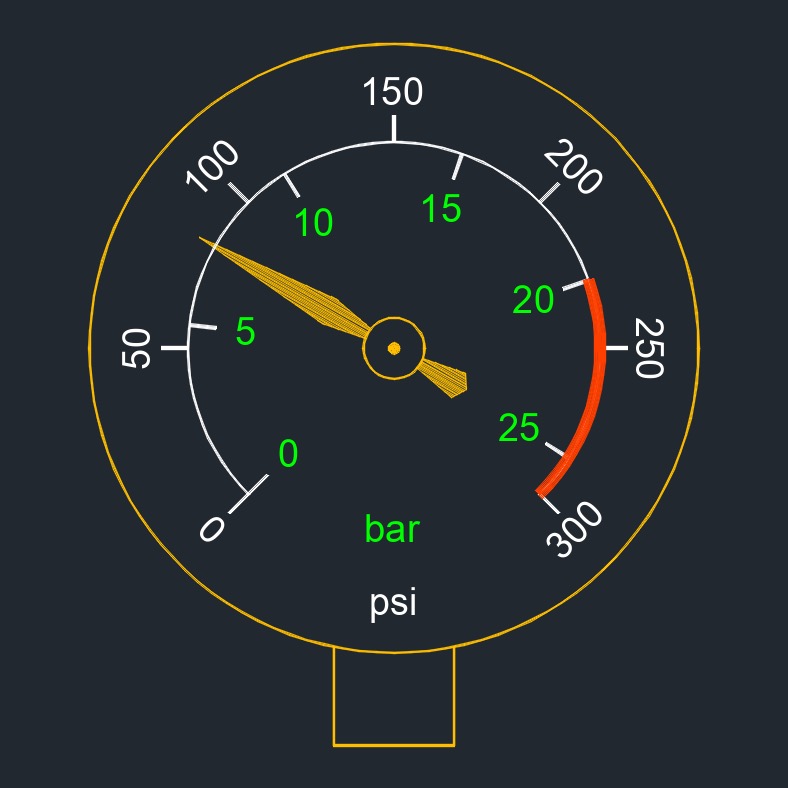Pressure Indicator
 A pressure indicator, abbreviated as PI, also called pressure gauge, is a device used to display the pressure of a fluid, gas, or vapor in a system. It provides a visual indication of the pressure level, typically through a dial gauge or digital display. It is a field instrument that requires little to no maintenance.
A pressure indicator, abbreviated as PI, also called pressure gauge, is a device used to display the pressure of a fluid, gas, or vapor in a system. It provides a visual indication of the pressure level, typically through a dial gauge or digital display. It is a field instrument that requires little to no maintenance.
features and functions of a pressure indicator
- Pressure Measurement - The primary function of a pressure indicator is to measure the pressure of the fluid within a system. It utilizes a pressure sensing element, such as a Bourdon tube, diaphragm, or piezoelectric crystal, to detect changes in pressure.
- Display - The pressure indicator features a display mechanism that visually indicates the measured pressure. This display can be in the form of a circular dial gauge with a pointer or a digital display with numeric readouts. The display unit typically shows the pressure in units such as psi, bar, Pascal, or other pressure units depending on the application.
- Accuracy and Range - Pressure indicators are available in various pressure ranges and accuracy levels to suit different applications. The range and accuracy of the indicator should be selected based on the specific requirements of the application and the expected pressure range.
- Process Connection - Pressure indicators feature process connections that allow them to be connected directly to the system or pipeline where pressure measurement is required. The selection of the process connection depends on factors such as system pressure, temperature, and compatibility with the process fluid.
- Mounting Options - Pressure indicators can be mounted in various orientations, including vertical, horizontal, or inverted, depending on the specific requirements of the application. They are often installed directly on pipes, vessels, or equipment using threaded connections or flanges.
- Temperature Compensation - Some pressure indicators incorporate temperature compensation features to ensure accurate measurements over a wide range of operating temperatures. Temperature variations can affect the performance of the sensor, and temperature compensation helps maintain measurement accuracy.
- Applications - Pressure indicators find applications in various industries, including oil and gas, petrochemical, chemical processing, HVAC, water and wastewater treatment, and manufacturing processes. They are used for monitoring pressure in pipelines, tanks, vessels, pumps, compressors, and other equipment.
How it Works
Process Pressure Gauges function when the process fluid enters a Bourdon Tube or similar enclosure. The Bourdon pressure gauge uses the principle that a flattened tube tends to straighten or regain its circular form in cross-section when pressurized. The amount of deflection in the tube drives a needle to display the pressure in the line. Depending on the pressure range, the Bourdon Tube will connect to a gear box to accurately measure the pressure.
Specifying
When choosing a PI, it is most important to select the correct materials that are in contact with the process. In steam applications special options may need to be selected. Sometimes, when the pressure indicator is installed downstream of a pump or in a service where there is high vibration, it may be necessary to have the case filled with fluid such as glycol or other oil. Glycol helps dampen the movement of the needle. Common pressure ranges are listed below. When selecting a pressure gauge, it is good practice to select a gauge where the operating pressure is halfway between the indicated range. For example, when operating pressures are 60 psi, a 0-100 psi range is appropriate.
Pressure Ranges |
|---|
| PSI |
| 0-15 |
| 0-30 |
| 0-60 |
| 0-100 |
| 0-160 |
| 0-200 |
| 0-300 |
| 0-400 |
| 0-600 |
| 0-800 |
| 0-1000 |
| 0-1500 |
| 0-2000 |
| 0-3000 |
| 0-5000 |
| 0-10,000 |
| 0-20,000 |
| 0-30,000 |
| 0-50,000 |
| 0-80,000 |
| 0-100,000 |


